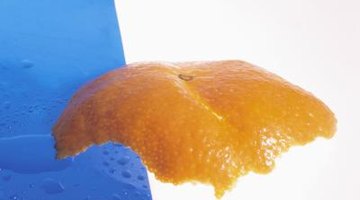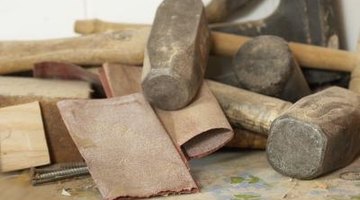What Causes Orange Peel When Painting?
Many techniques are used when painting surfaces. For all surfaces, whether an automobile, the interior walls of a building, crafts or even exterior walls and fences, an effect called orange peel is sometimes desirable by the painter and sometimes a nuisance. Orange peel is bumpy and uneven surface formation caused by poor coalescence of atomized paint droplets. These paint droplets dry before they can level out smoothly together. Different painting application processes may cause this effect.
Spray Gun Setup

When mixing paints for the spray gun, adding more activator or hardener into the clear coat can create problems. With improper flow of material, such as low paint gun pressure or an incorrect nozzle size, orange peel can result. Follow all recommended guidelines when using a paint spray gun, including nozzle size, reactants within the mixture, and pressure.
Distance
Spraying from the incorrect distance can also cause orange peel, as some of the paint starts to dry before it reaches the intended surface material, forming an uneven, non-uniform finish. Ambient temperature also plays a role in the distance required, as with a high temperature paint, which dries sooner. This causes the mixture of paint to lose more solvent as the ambient temperature rises.
Substrate Not Prepared Properly

Orange Peel can be the result of a surface not being prepared for painting properly. The surface to be painted should be clean and free of dirt, oils, peeling paint or stain products. Lightly sand the surface to rid it of any imperfections that may collect or trap paint, causing uneven paint flow. Fill in any holes present with caulking and create a smooth, even surface.
Rolling On
It is often desirable to create an orange peel effect when using a roller for interior surfaces. Sometimes it is something the painter wants to avoid when using a roller to paint concrete surfaces or even interior walls within a building. Use the correct roller when painting to get the desired effect. Some rollers are specifically designed to create an orange peel look, while others are designed for ultra smooth application of paint. A second coat of paint needs to be timed appropriately, with application before the first coat dries completely, to avoid uneven absorption. Back-roll once the entire coat is laid down to even out all imperfections.
References
Resources
Writer Bio
Sean Keven began writing professionally in 2011. Based in California, Keven has extensive knowledge of world history, military history and sports psychology. He is a graduate of California State University, Chico with a B.A. in journalism and a minor in forensic anthropology.
Photo Credits
- Hemera Technologies/AbleStock.com/Getty Images
- Jupiterimages/Photos.com/Getty Images
More Articles



